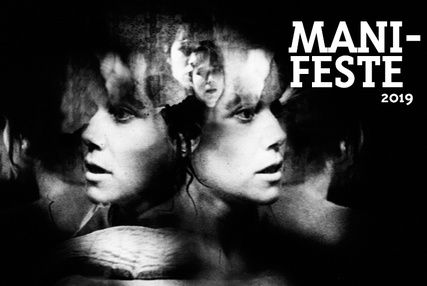Création musicale autour d'Outer Space
Un projet européen
C’est un projet d’envergure européenne qui est à l’origine de la présence de Javier Elipe Gimeno dans les studios de l’Ircam cette année : initié par l’Académie Impuls de Graz dans le cadre d’ULYSSES, ce réseau européen qui réunit diverses institutions, festivals et ensembles dédiés à la diffusion de la musique contemporaine (dont l’Ircam), ce projet précisément réunit huit jeunes compositeurs autour de l’œuvre de l’autrichien Peter Tscherkassky. Objectif : composer des musiques pour l’un des deux plus célèbres films du cinéaste expérimental : Outer Space (1999) et Dreamwork (2001), les deuxième et troisième volets du triptyque Cinemascope, réalisé à partir des images de L’emprise (1981), un film d’horreur hollywoodien. Lesquelles seront interprétées lors d’un ciné concert par l’Ensemble Nikel.
Outer Space trailer, by Peter Tscherkassky
Au cours d’un atelier-symposium organisé en février 2017, les huit compositeurs ont pu rencontrer Tscherkassky et échanger avec lui sur son univers et ses méthodes de travail. Ils ont également pu converser avec divers spécialistes du sujet (dont le compositeur Wolfgang Mitterrer), avant de se lancer dans le travail lui-même. Sélectionné avec Ariadna Alsina par l’Ircam pour participer au projet, Javier Elipe Gimeno a porté son dévolu sur Outer Space (1999), un film qui dégage une très grande violence, d’un bout à l’autre…
Un concerto pour film, ensemble et électronique
Pour Javier Elipe Gimeno, l’exercice de composer une musique pour un film n’est pas une nouveauté, bien au contraire. Même pour un film expérimental. Non seulement il en est à sa huitième tentative, mais il a aussi soutenu une thèse sur l’écriture de la musique contemporaine pour le cinéma muet, a mené un séminaire intitulé « Composer avec le cinéma expérimental » à l’université Paris-8 et enseigne encore sur le sujet dans différentes universités ! Grand amateur du travail de Peter Tscherkassky, le projet semble fait pour lui.
L’expérience engrangée a toutefois ses bons et ses mauvais côtés : « Une chose est certaine, dit-il : je ne veux pas refaire ce que j’ai déjà fait. Chaque projet me permet d’explorer une nouvelle direction, de l’évaluer, de constater ce qui fonctionne ou pas, puis de rééquilibrer l’approche pour le suivant. Chaque partition réoriente la démarche suivante. Et pour chacune, je me pose la même question : que doit être la musique d’un film ? À quoi sert-elle ? Quelle articulation entre la musique et l’image ? En mêlant chaque fois différentes perspectives : formelle, narrative, fonctionnelle (l’énergie infuse du sonore au visuel et vice versa), complémentaire… De fait, je compose moins une musique pour un film, que le rapport de la musique à ce film. »
« En 2013, à l’Ircam, pour un film muet à la narration trouble, j’ai voulu une musique très texturale, afin de ne pas troubler la vision des images. C’était donc une musique « en noir et blanc », comme le film, qui clarifie sa forme et, finalement, aide à sa compréhension. Après coup, j’ai trouvé que le résultat était trop vertical, et donc pas si intéressant que cela : pour moi, la musique doit toujours pouvoir être écoutée sans l’image. Pour le projet suivant, j’ai donc produit un discours plus horizontal et narratif. Et là encore j’en ai tiré des leçons pour la suite. »
 Outer Space, Peter Tscherkassky
Outer Space, Peter Tscherkassky
« Outer Space est un film très énergique, avec des mouvements tout le temps, jalonné de deux climax. Une musique qui évoluerait en parallèle ne fonctionnerait pas : ce serait trop redondant. D’un autre côté, si on ne souligne pas les deux climax, l’impression peut être très déstabilisante. Je me suis donc attaché à faire l’analyse des mouvements du film, sur papier millimétré, ainsi que celle d’autres paramètres (tels que la lumière, l’intelligibilité des images) à l’aide d’outils informatiques grâce au Réalisateur informatique musicale qui m’accompagne, Carlo Laurenzi. Cela afin d’établir un rapport complexe, avec des moments de synchronisation pure et d’autres de parallélisme relatif (c’est-à-dire un parallélisme non synchrone, ponctué de phénomènes d’anticipation ou d’association, de contrepoint narratif et de rappel). »
« Mon idée est de tenter de réaliser une “orchestration audiovisuelle”. Par exemple, le début du film est scandé de nombreux effets stroboscopiques. Du point de vue du musicien, ces effets figurent comme un ostinato rythmique, un tremolo ou un trille, mais je n’ai nul besoin de le souligner musicalement, puisqu’il est si présent à l’image. Au contraire, cet ostinato peut être doublé par différents modes de jeu : des pizzicati ou une succession d’accords, par exemple… Puis, quand l’effet stroboscopique s’arrête, la musique peut prendre le relais, comme en réponse. De la même manière, le deuxième climax du film est très agressif : les images sont très agitées, tout semble voler à l’écran. Musicalement, je prépare ce par une montée en tension de l’énergie – qui se communique ensuite à l’écran, alors que la musique se calme d’un coup. Ce moment est très délicat, parce que je veux aussi préserver ce sentiment de vide que provoque le film. On ne peut donc avoir constamment recours à de la saturation ou des multiphoniques, on ne peut pas trop charger la musique. Les silences inconfortables sont parfois plus puissants qu’un gros son : il faut nettoyer, préserver le vide, le blanc. Le film est très physique, la pellicule est nue, et cela dégage une énergie brute que je veux conserver. C’est aussi ça, “l’orchestration audiovisuelle”. »
Enjeux technologiques
Au cours de son Cursus à l’Ircam, le gros du travail de Javier Elipe Gimeno pour Frequencies of metal pour tuba et électronique avait porté sur Modalys, c’est-à-dire un moteur de synthèse par synthèse physique – qui permet, par exemple, de faire sonner une corde virtuelle de dimensions et caractéristiques difficiles de créer dans la réalité, sans avoir à la confectionner effectivement. L’idée était de former, derrière le tuba du soliste, un « orchestre de tubas » virtuels, capable de vibratos originaux obtenus en variant, en temps réel, la longueur du tuyau !
Frequencies of metal, Javier Elipe Gimeno
« C’était très amusant mais très complexe, se rappelle le compositeur. Les textures obtenues étaient assez étranges, à la fois réelles et irréelles : j’aime jouer de cette ambiguïté, et c’est aussi en partie ce que j’ai voulu faire ici, en écho au sentiment de réalité/irréalité du film de Tscherkassky. Avec Carlo Laurenzi, nous avons également travaillé avec des outils de synthèse concaténative, afin de créer des gestes instrumentaux complexes, qui seront imités dans la partition par les instruments de l’Ensemble Nikel. »
Précédents projets à l'Ircam
2013 – Frequencies of metal pour tuba et électronique (pièce réalisée dans le cadre du Cursus de l’Ircam)
2013 –Plus tard, musique pour un film d’Éric Oriot, réalisée dans le cadre de l’atelier In Vivo Vidéo de ManiFeste, dirigé par Andrea Cera.
2015 - Diable, Écoute, musique pour un film de Clio Simon, produit par le Fresnoy, et collaboration avec l’Ircam.
2017 - Is it a true story telling ?, musique pour un film de Clio Simon, coproduit par l’Ircam, Hors Pistes-Centre Pompidou et le Fresnoy-Studio national des arts contemporains.






